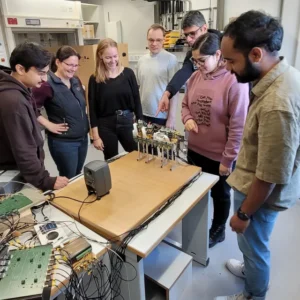For more see the News and Blogs Archive
Featured
News
Electronic Engineering Journal, 20 November 2025
We live in exciting times with respect to AI and the devices used to implement inferencing at the edge, where the “internet rubber” meets the “real-world road,” as it were. It reminds me of those distant days in the 1970s when we were all “feeling our way” with 8-bit microprocessors. I’m thinking of devices like the Intel 8008 (1972), Intel 8080 (1974), Motorola 6800 (1974), MOS Technology 6502 (1975),…
New Artificial Neurons Physically Replicate the Brain
SciTechDaily, 2 November 2025
A breakthrough in neuromorphic computing could lower the energy consumption of chips and accelerate progress toward artificial general intelligence (AGI). Researchers from the USC Viterbi School of Engineering and the School of Advanced Computing have created artificial neurons that closely mimic the complex electrochemical behavior of real brain cells. Their breakthrough,…
China builds brain-mimicking AI server the size of a mini-fridge, claims 90% power reduction — BI Explorer 1 packs in 1,152 CPU cores and 4.8TB of memory, runs on a household power outlet
tom's HARDWARE, 28 October 2025
Chinese scientists have unveiled what they call the "world's first brain-inspired computing entity," an AI "supercomputer" called the BIE-1, inspired by the operation of the human brain. While this claim to be the world's first isn't entirely accurate, the BIE-1 still offers exciting neuromorphic performance numbers, reportedly featuring 1,152 CPU cores and 4.8 TB of DDR5 memory while claiming to consume…
Nuclear Startups May Miss the AI Power Boom as Efficiency Gains Explode
investing.com, 10 October 2025
This Technology May Slash AI Energy Use by 1,000x – Arriving Years Before Oklo’s First Reactor. Investors have poured $45 billion into zero-revenue nuclear startups like Oklo (NYSE:OKLO), betting AI data centers will drive insatiable power demand for decades. But a convergence of energy-efficient computing technologies already demonstrating 100-1,000x efficiency gains in laboratories threatens to…
A Theoretical Framework for Neuromorphic Technology?
EE Times Current, 10 October 2025
Brad Aimone from Sandia National Labs works with the world’s biggest neuromorphic platforms. In this episode of Brains and Machines, he talks to Sunny Bains of University College London about how this allows him to think deeply about what they’re good for. Discussion follows with Giulia D’Angelo from the Czech Technical University in Prague and Professor Ralph Etienne-…
Korea, with global semiconductor research, will make a huge investment in 10 years
MAEIL BUSINESS NEWSPAPER, 3 October 2025
The competitiveness of Korean researchers in neuromorphic semiconductors is among the top in the world. Korea is the market where we can see the result." Seok Min-koo, a professor of electrical engineering at Columbia University, told the Maeil Business Newspaper that Korea can gain an advantage in the paradigm shift of semiconductor technology as it shows strength in neuromorphic…
A New Brain-on-a-Chip May Usher in the Beginning of the Singularity
POPULAR MECHANICS, 23 September 2025
Here’s what you’ll learn when you read this story: Memristors, or “memory resistors,” are the leading candidate for replacing synapses in a neuromorphic (brain-like) computer. Earlier this year, Korea Advanced Institute of Science and Technology, or KAIST, announced the development of a self-learning memristor that’s even better at replicating the synapses in our brain. This could allow AI computing to occur locally while also being more energy efficient and capable of improving at tasks over time….
King’s joins UK’s first brain-inspired computing innovation centre
King's College London, 16 September 2025
Along with King’s academics from NMES and IoPPN, Professor Bipin Rajendran from the Department of Engineering will lead the King’s team which is part of the UCL-led Neuroware centre. The centre seeks to accelerate the development of next-generation brain-inspired computing technologies and their deployment onto computer chips. This will help underpin new advancements in edge AI,…
Neurons Close the Loop from Insect Perception to Action
EE Times Current, 10 September 2025
Professor Barbara Webb from the University of Edinburgh in Scotland uses physical robots to validate neural mechanisms in crickets, ants, and bees. In this episode of Brains and Machines, she talks to Dr. Sunny Bains of University College London about her work. Discussion follows with Dr. Giulia D’Angelo from the Czech Technical University in Prague and Professor Ralph Etienne-Cummings…
Neuromorphic computing: Mimicking the human brain for smarter AI
DATAQUEST, 29 August 2025
From Intel's Loihi to breakthroughs in memristors, neuromorphic computing offers potential breakthroughs with more energy-efficient, adaptive, and brain-like data processing capabilities that could change the way we build smarter and more sustainable AI. The first time I witnessed a child stack blocks, I felt like I was watching a miniature computer learn. She didn't plan the tower, she felt for balance…
For more see the News and Blogs Archive or Suggest a Story











